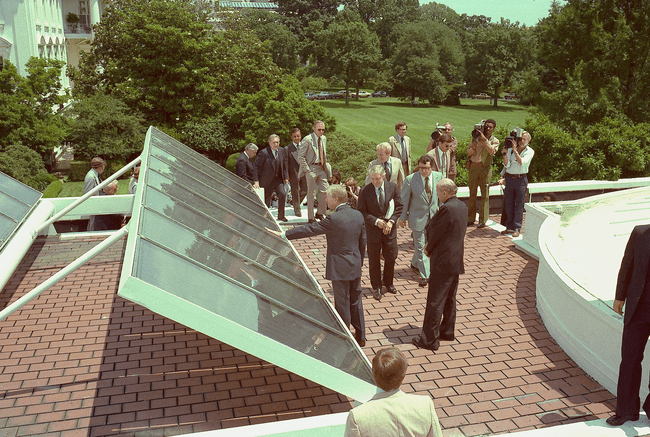Jimmy Carter Takes a Stand
Text by Pierre-Édouard Latouche
Jimmy Carter was the first American president to take decisive steps to promote solar energy. Having studied to be a nuclear engineer in the 1950s, at a time when nuclear and solar energy were seen as having the potential to replace coal and oil, he went on to be a strong supporter of renewable energy sources during his presidency. His term in office saw the formulation of an energy policy (1977), the creation of the Department of Energy (1977) and the Solar Energy Research Institute (1977), the National Energy Act (1978), and the first national Sun Day (3 May 1978).1
For the general public these measures took the form of a tax credit covering about a third of the cost of installing solar equipment in new or already-built houses. Less well-off families were entitled to low-interest loans through a federal mortgage assistance program.2 Carter set the example by officially introducing a solar water-heating system for the White House in 1979.3
Despite these positive steps, few actual results were achieved in the construction industry. There was indeed an increase in the number of manufacturers of solar panels – from 186 in 1977 to 349 in 1979 – but the panels were mainly used to heat swimming pools. The target Carter set in 1977, to build 300,000 solar houses a year, was never met. The number of solar dwellings built between 1977 and 1985 never exceeded 4,200, in other words, only 0.20% of new single-family home construction in the US.4
Ronald Reagan’s election in 1980 dealt a fatal blow to the development of solar energy for the housing and business sectors.5 An excellent communicator, Reagan managed to convince the American people that the energy crisis was not due to dwindling oil or gas resources – these were supposedly abundant – but rather to bureaucratic interference in supply and demand in the energy sector. In 1986 Reagan had the solar panels his predecessor installed removed from the White House.
-
Carter’s policy on solar energy is analyzed brilliantly by Lamont C. Hempel in The Politics of Sunshine: An Inquiry into the Origin, Growth and Ideological Character of the Solar Energy Movement in America (Ann Arbor, Mich.: UMI, 2007), 141–227; see also Bruce Anderson, “Introduction,” in Solar Building Architecture (Cambridge, MA: MIT Press, c. 1990), 1–35. ↩
-
Hempel, The Politics of Sunshine, 151–52. ↩
-
Ted Shelton, “The Greening of the White House,” in Journal of Architectural Education 60, no. 4 (May 2007): 31–38. ↩
-
The figures refer to the period covered by the tax credits for installing solar devices, i.e., until Dec. 1985. See US Census, Statistical Abstract, 1994. The number of solar houses built in the US that we propose is calculated based on a statistic from the US Census, namely, the total surface area in ft2 of solar panels for heating houses manufactured in the USA, divided by the average surface area of panels for an individual house, i.e., 560 ft2 (18 m2). ↩
-
For the impact of Reagan’s policies, see Hempel, The Politics of Sunshine, 207–08; and Anderson, Solar Building Architecture, 11. ↩
Pierre-Édouard Latouche was a member of the curatorial team for our 2007 exhibition 1973: Sorry, Out of Gas. This text was published for the first time in the accompanying publication, Sorry, Out of Gas.














